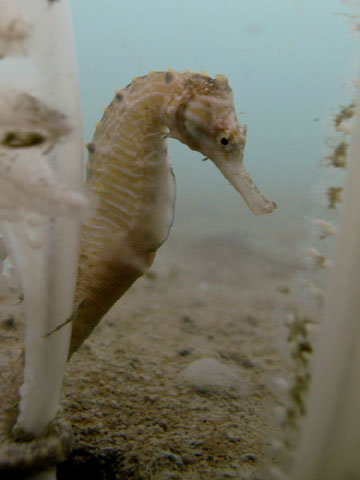| Syngnathidae (Pipefishes and seahorses), subfamily: Syngnathinae |
| 22 cm TL (male/unsexed) |
|
reef-associated; marine; depth range 0 - 100 m, non-migratory |
| Indo-West Pacific: India to Tahiti; north to Japan, south to Indonesia. |
|
Dorsal spines (total): 0-0; Dorsal soft rays (total): 18-22; Anal spines: 0-0; Anal soft rays: 4-4. Description: (based on 54 specimens): Adult height: 8.0-15.0cm. Rings: 11+40-41 (38-43). Snout length: 2.2 (1.9-2.4) in head length. Dorsal fin rays: 20 (18-22) covering 2+1 rings. Pectoral fin rays: 17-18 (16-19). Coronet: very low, in line with arch of neck, visible as five tiny points. Spines: low and small to slightly raised. Other distinctive characters: very sharp hook-like cheek and eye spines; quite flat in appearance; narrow head; no nose spine.
Color pattern: golden orange, sandy colored or totally black; may have large dark spots on the dorsolateral surface of the first, fourth and seventh trunk ring (less visible in dark specimens, and more common in males than females); some specimens ‘zebra striped’ in brown and white. |
| Inhabits gravel or sand bottoms around shallow reefs (Ref. 559); muddy estuaries and near mangroves, tolerating brackish waters (Ref. 48635). Occur singly or in pairs (Ref. 128523). Ovoviviparous (Ref. 205). The male carries the eggs in a brood pouch which is found under the tail (Ref. 205). |
|
Vulnerable (VU); Date assessed: 06 September 2012 (A2bcd+4bcd) Ref. (130435)
|
| harmless |
|
Listed in the 1994 Vietnam Red Data Book (Ref. 30915). Known from the Gulf of Tonkin and central Vietnam (Ref. 9706), Nha Trang (Ref. 58534), Hon Ong and Phu Quoc Island, on soft bottom areas with silt, sand and seagrass (Ref. 129070).
Status of threat: Vulnerable (Ref. 46452), Endangered (Ref. 129070). |
Source and more info: www.fishbase.org. For personal, classroom, and other internal use only. Not for publication.

